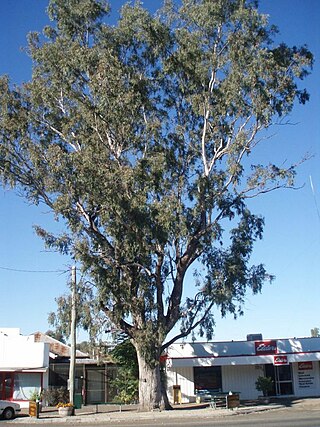
Grevillea wickhamii, commonly known as Wickham's grevillea, holly-leaf grevillea or lgarrmari in Djaru, is species of flowering plant in the family Proteaceae and is endemic to northern Australia. It is an erect shrub or spindly tree with holly-like, broadly egg-shaped leaves with 2 to 7 shallow teeth, and down-curved clusters of flowers, the colour depending on subspecies.

Cochlospermum is a genus of trees in the Bixaceae family; some classifications place this genus in the family Cochlospermaceae. It is native to tropical regions of the world, particularly Latin America, Africa, the Indian Subcontinent, and Australia.
Kapok fibre is a cotton-like plant fibre obtained from the seed pods of a number of trees in the Malvaceae family, which is used for stuffing mattresses and pillows, for padding and cushioning, and as

Eucalyptus microtheca, commonly known as the coolibah or coolabah, is a species of tree that is endemic to northern Australia. It has rough, flaky or fibrous bark on the trunk and branches, lance-shaped adult leaves, flower buds in groups of seven, white flowers and spherical to conical fruit. It is widely distributed from the Kimberley region of Western Australia to Cape York in Queensland.

Acacia platycarpa, commonly known as the pindan wattle or ghost wattle, is a species of plant in the legume family that is native to northern Australia from Western Australia through the Northern Territory to Queensland.

Corymbia flavescens, commonly known as cabbage ghost gum, bastard ghost gum, scraggy cabbage gum, or wrinkle-leaf ghost gum, is a species of tree that is endemic to northern Australia. It has smooth powdery bark, egg-shaped to lance-shaped adult leaves, flower buds in groups of three, white flowers and variably-shaped fruit. The Jaru peoples know it as warlarri.

Lysiphyllum cunninghamii is a species of plant in the family Fabaceae. It is native to northern Australia where it occurs from Western Australia through the Northern Territory to Queensland.

Premna acuminata, commonly known as the firestick tree, or ngalinginkil in the Bardi language, is a species of plant in the mint family. It is native to Northern Australia where it occurs from Western Australia through the Northern Territory to Queensland.

Atalaya hemiglauca, commonly known as whitewood or cattle bush, is a species of plant in the soapberry (Sapindaceae) family. It is native to northern and inland Australia where it occurs from Western Australia through the Northern Territory and South Australia to Queensland and northern New South Wales.
Gardenia pyriformis, commonly known as malara, native gardenia or turpentine tree, is a species of plant in the coffee family. It is native to northern Australia where it occurs from the Kimberley region of north-western Western Australia, across the Top End of the Northern Territory to northern Queensland.
Pavetta kimberleyana is a species of plant in the family Rubiaceae. It is native to northern Australia where it is largely restricted to the Kimberley region of north-western Western Australia.
Dodonaea hispidula is a species of flowering plant in the hop-bush genus of the soapberry family. It is native to tropical northern Australia, where it occurs from the Kimberley region of north-western Western Australia, across the Top End of the Northern Territory, to northern Queensland. In Western Australia it is found in the Central Kimberley, Dampierland, Northern Kimberley, Ord Victoria Plain and Victoria Bonaparte IBRA bioregions.

Ficus coronulata, commonly known as the peach-leaf fig, and in the Northern Territory as river fig and crown fig, is one of several fig species commonly known as sandpaper figs. It is native to Western Australia and the Northern Territory.

Hakea macrocarpa, commonly known as flat-leaved hakea, is a species of flowering plant in the family Proteaceae and is endemic to northern Australia. It is a tree or shrub with furrowed bark, woolly-hairy branchlets, narrowly linear leaves and cream-coloured to greenish-yellow flowers.

Scaevola browniana is a shrub in the family Goodeniaceae, endemic to Western Australia, the Northern Territory and Queensland.

Pityrodia ternifolia is a species of flowering plant in the mint family, Lamiaceae and is endemic to north-western Australia. It is an erect shrub with densely hairy stems, sticky and prickly, egg-shaped leaves, and mauve or pinkish-red, tube-shaped flowers.

Alysicarpus schomburgkii is a species of pea found in Australia, in the Northern Territory, Queensland, and Western Australia. It was first described in 1926 by Anton Schindler from four specimens: two collected at Port Darwin and the others from north Queensland.

Goodenia azurea, commonly known as blue goodenia, is a species of flowering plant in the family Goodeniaceae and is endemic to northern Australia. It is an erect, dense, spreading or sprawling, glaucous, perennial herb with egg-shaped leaves with the narrower end towards the base, racemes or thyrses of bluish-purple flowers with leaf-like bracts, and oval to cylindrical fruit.
Hibbertia oblongata is a species of flowering plant in the family Dilleniaceae and is endemic to northern Australia. It is an erect to spreading shrub with scaly foliage, elliptic to oblong leaves, and yellow flowers usually arranged singly in leaf axils, with 16 to 36 stamens arranged in bundles around the two carpels.

Goodenia panduriformis, commonly known as Pindan poison, is a species of flowering plant in the family Goodeniaceae and is endemic to north-western Australia. It is a glaucous herb with erect flower stems, glabrous, toothed, egg-shaped leaves with the narrower end towards the base, bracteoles joined to form a large disc, and deep- or brownish-yellow flowers.




















